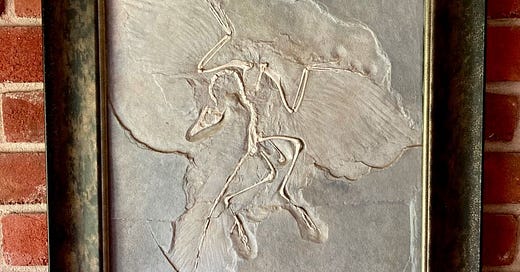One of the first things we hung on the walls when we moved into our house over 20 years ago was a cast of an Archaeopteryx. My husband, Steve, made it when he worked in a paleontology lab during college—a cast of a cast of the original. I thought it was beautiful, and we had a lot of space to fill (or so we thought at the time, ha ha). It has been on that wall ever since.
Over the years, it kind of became invisible. It caught my attention again during the pandemic, when we started doing exercise videos. The cluster of bones at its pelvis is right at my eye level, so I often focus there to hold my balance. With all that steady looking, my mind wanders—and wonders. How much does one individual matter? What happens to our stories out of context? What do we leave behind? You know, the usual 30-minute upper-body + cardio thoughts.
I’ve been thinking a lot about wings, birds, transformation, and layers of use/history lately, and of course I always love the amorphous space that exists where science, art, and writing overlap. It hadn’t occurred to me, when I started digging around for more information, that our Archaeopteryx might be an interesting piece of this.
Back around 1796, a playwright from the Bavarian region of Germany “accidentally discovered that he could duplicate his scripts by writing them in greasy crayon on slabs of limestone and then printing them with rolled-on ink.”1 He never became widely known, but his method of reproducing marks on paper did—first for writing, then for art. (Are art and writing actually different? More thoughts on that here and here). Thus was born lithography—a type of printmaking beloved for its ability to capture subtle darks and lights in great detail.
With the stone’s increased popularity came more quarries, and those quarries yielded, among other treasures, Archaeopteryx fossils. All thirteen2 specimens of Archaeopteryx3 come from this same Solnhofen Limestone4 that the playwright used, which is “a peculiarly fine grained and high-quality...”5 type of limestone. And Archaeopteryx has become an unparalleled tool for understanding the evolutionary link between dinosaurs and birds.6
Science, art, and writing! Hiding in plain sight, right in my very own house.
*
One last thing, speaking of hiding: My husband Steve—who says that the things he’d take with him in case of a fire (after making sure his family is safe!) would be his cello and this Archaeopteryx cast—has a rare and aggressive form of cancer. We are not hiding our situation, but I do not intend to talk about it much in this space. It is very much a presence in our lives, though. If you have questions or would like to talk more, feel free to contact me.
In other news:
The sixth annual Wild Wonder Nature Journaling Conference is just around the corner! It runs from 18-22 September, and will be packed with great teachers and speakers as always. This year’s roster includes Sefi George, whose work I am familiar with through the Creature Conserve Mentorship Program, as well as Yvea Moore and Kate Rutter, who have been guests on Twig & Ink. I will be working behind the scenes, so maybe I’ll see you there!
Also, if you’ve spent much time around me outside, you probably know how much I enjoy the Merlin bird ID app. In addition to these needle-painted birds being beautiful, many also incorporate visual representations of the bird songs!
https://www.metmuseum.org/toah/hd/lith/hd_lith.htm
Many sources still list the number as twelve, but the newest Archaeopteryx has debuted and will be on display soon, at the Field Museum in Chicago.
The cast we have is of the most complete specimen. It’s housed in Berlin, so it’s called the Berlin specimen.
This type of stone is still used for lithography today, though aluminum is a more easily accessible substitute.
Norman, David. Illustrated by John Sibbick. The Illustrated Encyclopedia of Dinosaurs. Crescent Books: New York, 1985.
Please note that I am not an expert on any of this, just a recent enthusiast. If you have corrections or additional information, I’d love to learn more!






Thank you for the photo of your treasured art. It is truly special. My granddaughter just entered the second grade and they begin the year with the study of birds. The class has groups with each group representing a bird that they will study throughout the year. She is excited. First grade was insect and bugs from top to bottom. You start that conversation and you will be overwhelmed with information.
Lisa, I have long thought that “ noticing” is a skill crucial to a number of things that interest me such as creativity, learning and leadership. A book I think you would enjoy is “ On Looking: Eleven Walks with Expert Eyes,” by Alexandra Horowitz.